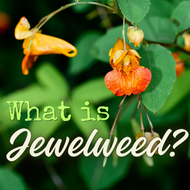Jewelweed: What is it?
Apr 16th 2024
Have you heard of jewelweed? If your answer is no, you’re not alone by far. In fact, since I launched my Jewelweed Goat Milk Soap in April of 2024, lots of questions have been coming in from people wanting to know more about this interesting plant. It is only in the last several years that I have learned about it and it immediately found a place on my radar for (I feel) good reason.
Working with jewelweed and incorporating it into my soap recipes was a learning process that didn’t happen overnight. Definitely not an “early bird gets the worm” situation in means of rushing the process. Like plantain, jewelweed 100% falls into the category of good things happen to those who wait. I will explain why at the end of this.
First it is important to answer some questions so you can get a feel of what jewelweed is, what many people use this “weed” for and why, and some additional resources if you want to know more. If you have a question that I haven’t included below, please let me know!
1. What is jewelweed?
Jewelweed, scientifically known as Impatiens capensis, is a wild plant native to North America. It's often found in damp, shady areas like woodlands, along streams, and near ponds. This humble plant has earned itself a reputation as a natural remedy for various skin irritations, thanks to its unique properties.
2. What does it look like and how do you identify it in nature?
Imagine a plant with succulent stems, smooth leaves, and delicate trumpet-shaped flowers in shades of orange or yellow. That's jewelweed! Its distinctive appearance makes it easy to spot in the wild, especially in moist environments.
3. Where is it commonly found?
Jewelweed can be found across North America, from the East Coast to the Midwest and beyond. In North Carolina, you might stumble upon jewelweed while exploring forested areas, near creeks, or along hiking trails.
4. Why is it also sometimes called touch-me-not?
One of the most intriguing things about jewelweed is its nickname: touch-me-not. This name comes from the plant's unique seed pods, which explode upon touch, scattering seeds in all directions. It's nature's way of ensuring the survival of the species!
5. Why is jewelweed often associated with poison ivy?
Ah, the poison ivy connection! Jewelweed has a long history of being used as a remedy for poison ivy rash. It's believed that the sap from jewelweed stems and leaves contains compounds that help soothe itching and irritation caused by poison ivy and other skin irritants.
6. What are some common uses for jewelweed?
Aside from its association with poison ivy, jewelweed has other handy uses. It's been used traditionally to soothe insect bites, stings, rashes, and minor burns. Some even swear by jewelweed's ability to calm eczema and other skin conditions.
7. What are the benefits of using a goat milk soap that contains jewelweed?
When jewelweed teams up with goat milk soap, it's a match made in skincare heaven! Goat milk soap is known for its moisturizing properties, while jewelweed adds soothing benefits. Together, they can help hydrate and calm irritated skin, leaving it feeling soft and refreshed.
8. Is jewelweed soap safe for sensitive skin?
Absolutely! Jewelweed soap is generally safe for sensitive skin types, thanks to its gentle and natural ingredients. However, it's always a good idea to perform a patch test before using any new skincare product, especially if you have allergies or sensitivities
9. Resources for learning more about jewelweed:
- BOOK: The Lost Book of Herbal Remedies by Nicole Apelian & Claude Davis (Highly recommend!)
- The Herb Society of America: This organization provides detailed information about various herbs and their uses, including jewelweed.
- The U.S. Forestry Service: Includes description, images, and uses for jewelweed.
- Integrated Taxonomic Information System (ITIS) Report U.S. Department of Agriculture
- PLANTS National Database, a website supported by the Natural Resource Conservation Service.
- The
University of Michigan – Dearborn, maintains an ethobotanical database that contains other interesting information on jewelweed. Georgia Dept. of Natural Resources: Great descriptions of jewelweed and how it is planted.
The Jewelweed Goat Milk Soap that I have created has taken a lot of time. As I said in the beginning, it is definitely one of those products where good things come to those who wait. It is the same soap recipe that I use in my other old fashioned goat milk soaps with one huge exception. Typically from beginning to end, it takes about two months for my soaps to cure and be ready to use. With the Jewelweed Goat Milk Soap, I tack on an additional two months before that of infusing the olive oil used in the recipe with dried jewelweed and calendula. So essentially one batch can take four months to complete.
Please know it's important to remember that while jewelweed and jewelweed soap have their benefits, they're not meant to diagnose or treat any skin problems. If you have concerns about your skin, it's best to consult with a healthcare professional for personalized advice and treatment options… including poison ivy exposure.
I am not a doctor. I am not a scientist. I am not anything in between. What I AM is a girl on a farm raising dairy goats to make what I feel is pretty darn good soap. And that includes constantly learning, researching, testing, sometimes failing, paying attention when I do, and never taking anything for granted.
The only reason I am able to do what I do is because of those of you supporting and following my journey. Thank you to everyone who seeks out and supports small businesses no matter where you are.

